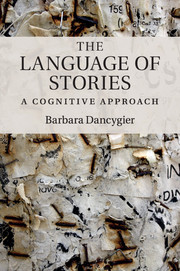Book contents
- Frontmatter
- Contents
- Figures
- Acknowledgements
- Introduction
- 1 Language and literary narratives
- 2 Blending, narrative spaces, and the emergent story
- 3 Stories and their tellers
- 4 Viewpoint
- 5 Referential expressions and narrative spaces
- 6 Fictional minds and embodiment in drama and fiction
- 7 Speech and thought in the narrative
- 8 Stories in the mind
- Notes to the text
- References
- Literary works cited
- Index
1 - Language and literary narratives
Published online by Cambridge University Press: 05 November 2011
- Frontmatter
- Contents
- Figures
- Acknowledgements
- Introduction
- 1 Language and literary narratives
- 2 Blending, narrative spaces, and the emergent story
- 3 Stories and their tellers
- 4 Viewpoint
- 5 Referential expressions and narrative spaces
- 6 Fictional minds and embodiment in drama and fiction
- 7 Speech and thought in the narrative
- 8 Stories in the mind
- Notes to the text
- References
- Literary works cited
- Index
Summary
There is nothing so strange it cannot be true, and no story so unlikely it cannot be told. No story is a lie, for a tale is a bridge that leads to the truth.
(The Arabian Nights, retold by Neil Philip)This book is about how the centuries-old thoughts quoted above are indeed true. Why are stories not lies, even though they don’t tell the truth? How do they help us to learn from our experience and the experience of others? And how does language support the meaning of stories? The structure of that “bridge . . . to the truth” is what I will try to understand.
The human ability, or even desire, to tell, understand, watch, and create stories has engaged a number of disciplines, each of which poses a different set of questions about the core of the phenomenon. Why do we enjoy stories? What’s in it for us as a species? Could our culture exist without stories? Are they a mental construct, a linguistic construct, or a cultural construct? Is there a difference between real stories and fictional stories? These are just some of the questions of interest to anthropologists, psychologists, narratologists, philosophers, linguists, and literary scholars. The answers have been, by necessity, partial, and directed at the interests of the disciplines they emerge from, but it is becoming increasingly clear to all concerned that some cross-disciplinary dialogue is necessary. This book is an attempt to bring together at least some of the questions out there while focusing on one central aspect of storytelling: how do stories construct meaning?
- Type
- Chapter
- Information
- The Language of StoriesA Cognitive Approach, pp. 4 - 30Publisher: Cambridge University PressPrint publication year: 2011



